International advertising forms the backbone for business expansion and achieving a noticeable presence in overseas markets.
Running global marketing campaigns while focusing on local store ads may seem like an uphill battle.
However, with the right strategies, you can blend global outreach with localized approaches to connect with diverse audiences.
In this article, we’ll explore practical tips and techniques to elevate your Google Ads campaigns and effectively strategize your global marketing efforts.
- Understand Your Target Audience in Global Markets
- Leverage Location-Based Advertising Techniques
- Adapt Your Marketing Message to Local Cultures
- Utilize Data Analytics to Monitor and Improve Campaigns
- Integrate Online and Offline Marketing Strategies
- Summary: Strategizing Global Marketing with Local Store Ads
- Global Marketing for Local Store Ads: Frequently Asked Questions
Understand Your Target Audience in Global Markets
Before diving into global marketing, it’s essential to understand who your audience is and what they need.
Different regions have unique cultural preferences, purchasing behaviors, and market dynamics that require a tailored approach.
By thoroughly analyzing your target audience, you can create more effective and engaging campaigns.

Visualizing market research for global regions with highlighted local preferences.
Conduct Market Research to Identify Local Preferences
Market research is the first step in understanding the preferences and behaviors of your audience in different regions.
Find out what products or services are in demand and how they align with the expectations of local consumers.
- Survey local consumers for insights about their needs and challenges.
- Leverage tools like Google Trends to identify regional interests and search behavior.
- Study online forums, reviews, and community discussions to understand local sentiment.

Illustrating the analysis of competitor strategies across various global regions.
Analyze Competitor Strategies in Different Regions
Your competitors can be a goldmine of information.
Observing their strategies in specific markets can give you a clear idea of what works and what doesn’t.
- Look at the ad formats and messaging your competitors are using.
- Analyze their website localization efforts, including language and cultural adaptations.
- Check their pricing strategies and promotions tailored to local markets.

Visual representation of audience segmentation based on cultural diversity and tailored marketing.
Segment Your Audience Based on Cultural Differences
Segmentation is key to ensuring your campaigns resonate with the right audience.
By grouping your audience based on cultural, economic, and behavioral differences, you can tailor your marketing efforts to suit each segment.
- Create buyer personas for each region to visualize your ideal customers.
- Emphasize localized messaging that reflects specific cultural values.
- Use demographic and psychographic data to refine audience segmentation.
When you understand your audience at a granular level, you can create campaigns that speak directly to them, increasing engagement and conversions in your global marketing efforts.
Understanding your target audience is the cornerstone of any successful global marketing strategy. Cultural preferences and behavioral insights ensure your campaigns resonate effectively.
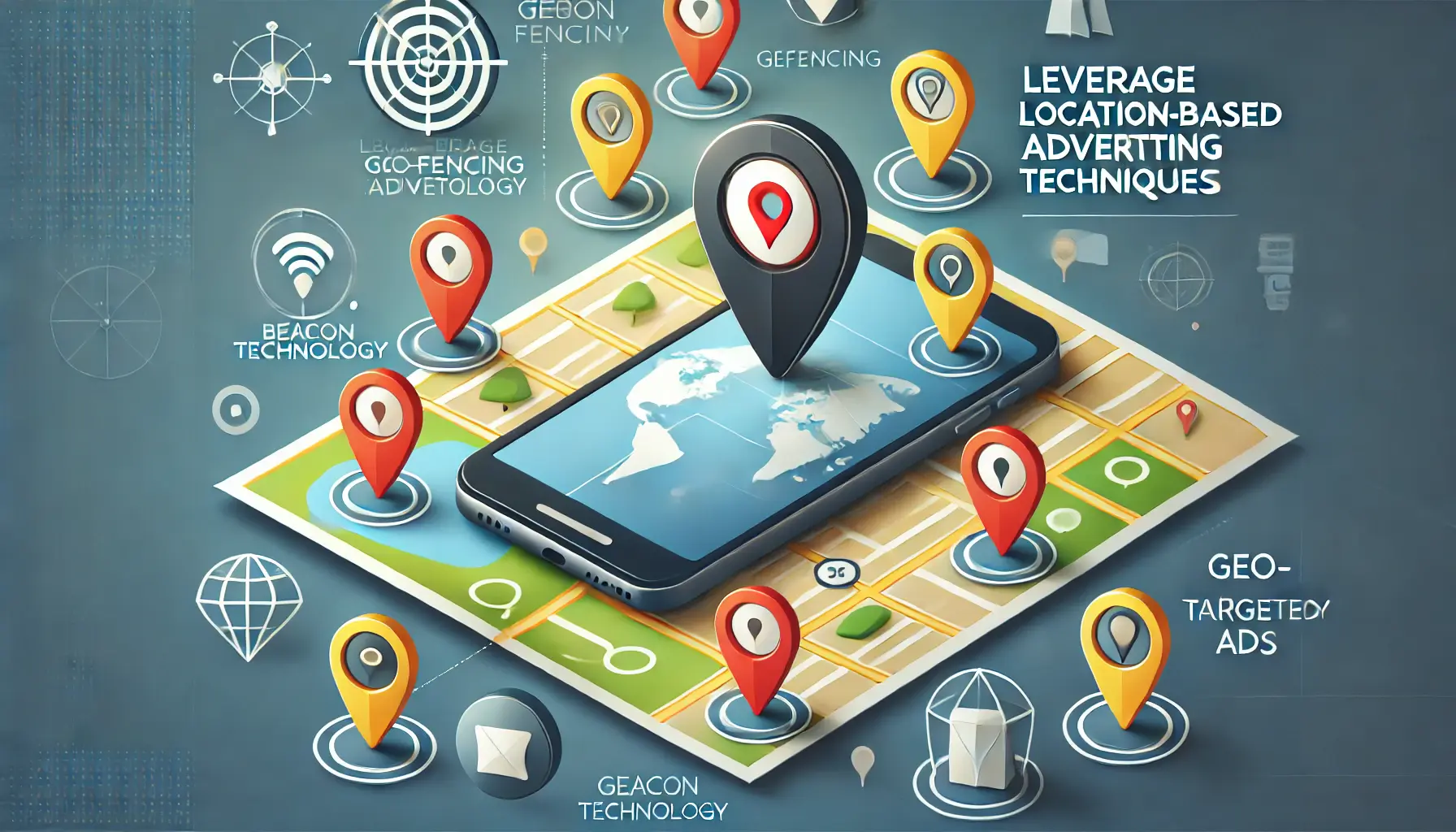
Visualizing location-based advertising techniques such as geo-targeting and geofencing.
Leverage Location-Based Advertising Techniques
In today’s digital landscape, location-based advertising has become a cornerstone of effective global marketing strategies.
By delivering personalized content to users based on their geographical location, businesses can enhance engagement and drive conversions.
Let’s explore how you can leverage these techniques to boost your marketing efforts.

Illustrating geo-targeted online advertising with connected devices and location-based targeting.
Implement Geo-Targeted Online Advertising
Geo-targeting enables you to address audiences in specific locations so your message reaches the right people at the right place and time.
This accuracy enhances relevance, driving up engagement rates.
- Define Target Areas: Select the countries, regions, or cities where your ideal customers reside.
- Use Local Language and Currency: Customize ad content to reflect the local language and currency, making it more relatable to the audience.
- Schedule Ads Appropriately: Align your ad schedules with the local time zones to maximize visibility and engagement.

Illustrating personalized promotions using location-based services like geofencing and beacon technology.
Utilize Location-Based Services for Personalized Promotions
Location-based services (LBS) enable you to offer promotions and content tailored to a user’s current location, enhancing the personalization of your marketing efforts.
- Geofencing: Set up virtual boundaries around specific areas to trigger targeted ads when users enter these zones.
- Beacon Technology: Use beacons in physical stores to send personalized offers to customers’ smartphones, enhancing in-store engagement.
- Localized Push Notifications: Send location-specific notifications to app users, informing them of nearby deals or events.
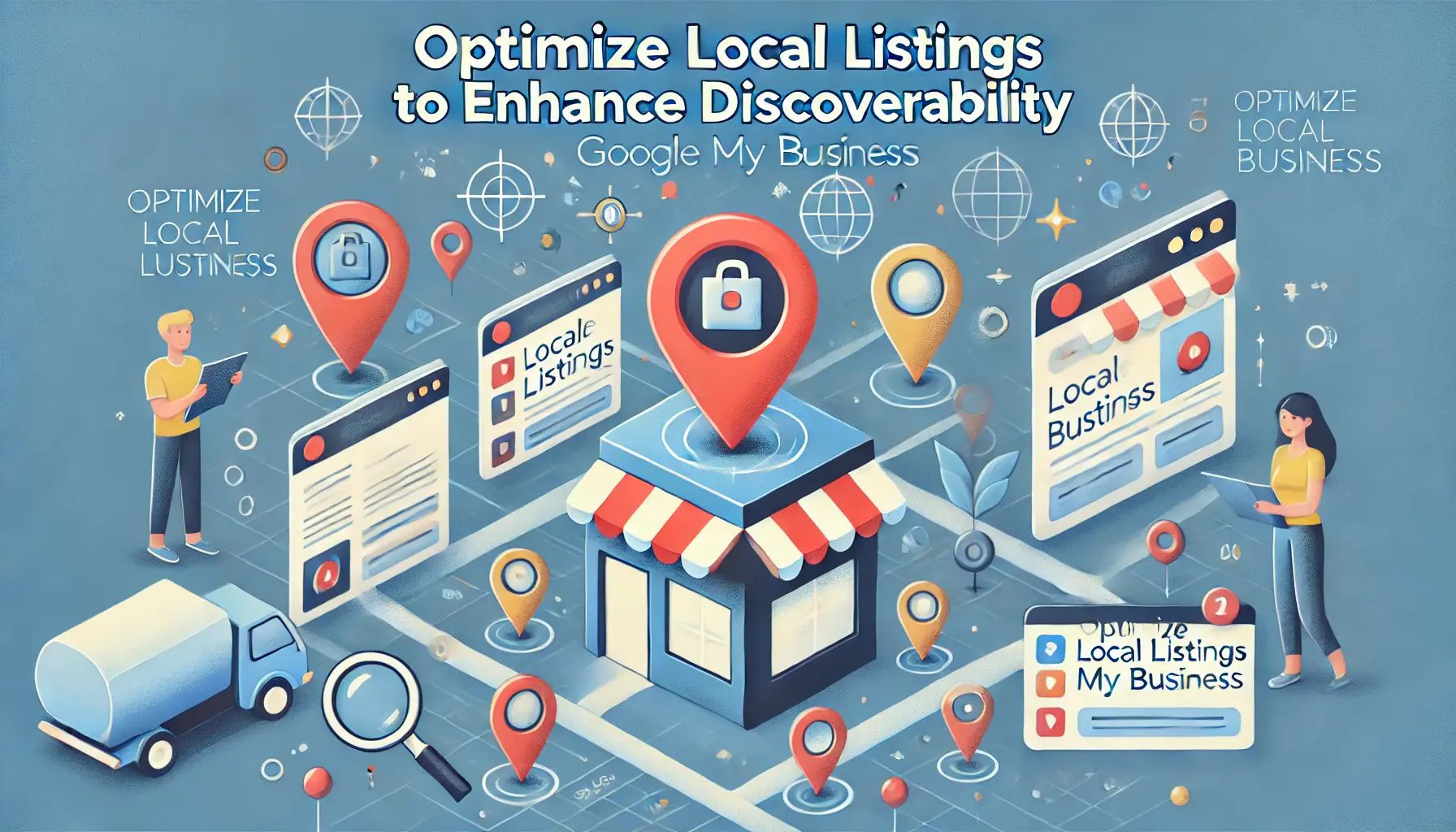
undefined
Optimize Local Listings to Enhance Discoverability
Ensuring your business appears in local search results is crucial for attracting nearby customers.
Optimizing your local listings improves visibility and drives foot traffic to your physical stores.
- Claim and Update Listings: Ensure your business is listed on platforms like Google My Business, and keep the information accurate and up-to-date.
- Encourage Customer Reviews: Positive reviews boost your local search ranking and build trust with potential customers.
- Use Local Keywords: Incorporate location-specific keywords into your website and listings to further improve SEO.
By using these location-based advertising techniques, you can create more personalized and meaningful marketing campaigns for your local target audiences, ultimately enhancing your global marketing strategy.
Location-based advertising increases the relevance of your campaigns. Techniques like geo-targetingDelivering content or advertisements to users based on their geographic location. and local listings optimization help connect with nearby customers effectively.
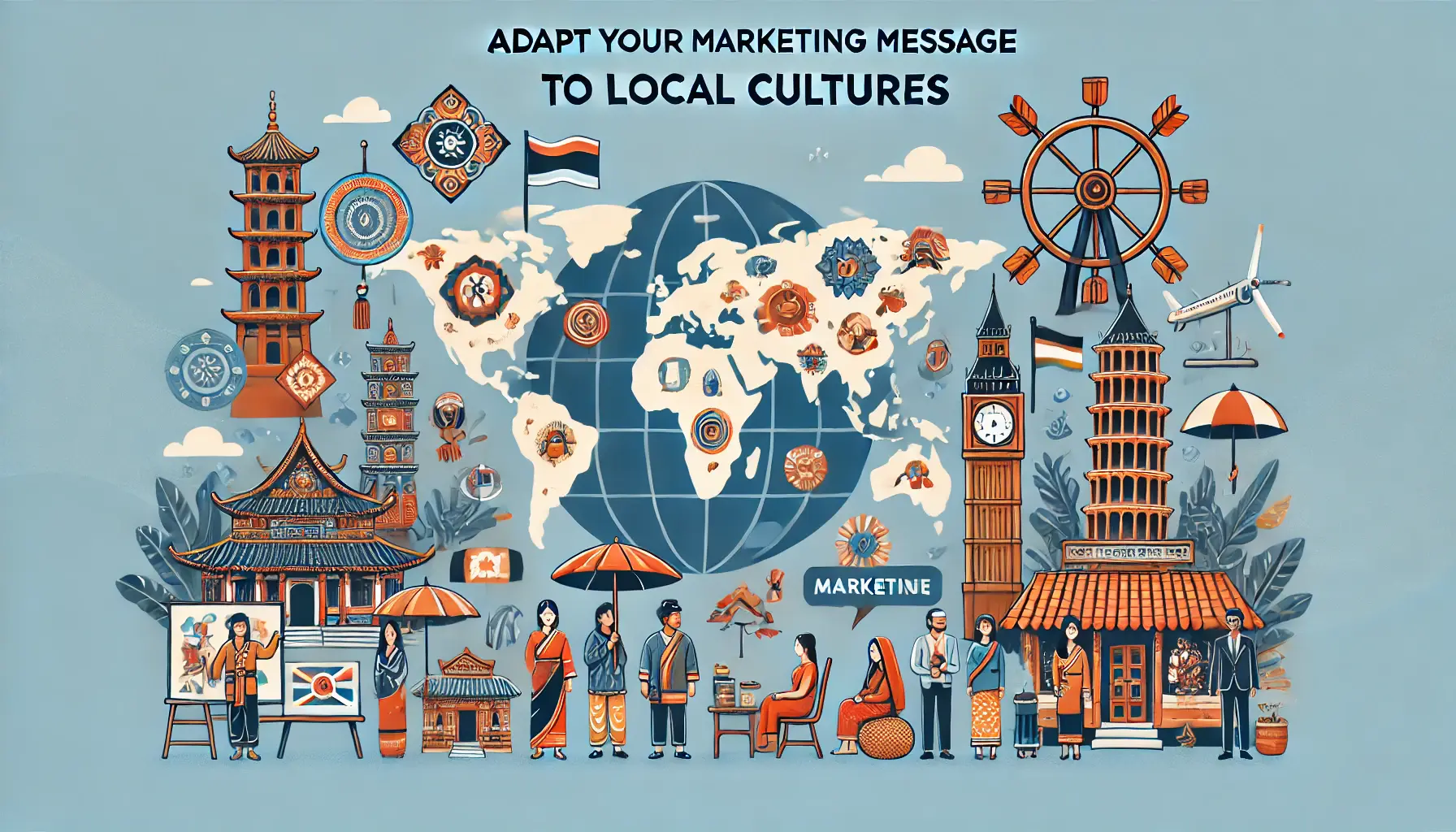
Visualizing the adaptation of marketing messages to different cultural settings and traditions.
Adapt Your Marketing Message to Local Cultures
In global marketing, adapting your message to resonate with local cultures is essential.
This approach, known as localizationAdapting content to reflect regional languages, customs, and cultural nuances., ensures your brand communicates effectively across diverse cultural landscapes, enhancing engagement and building trust with your audience.
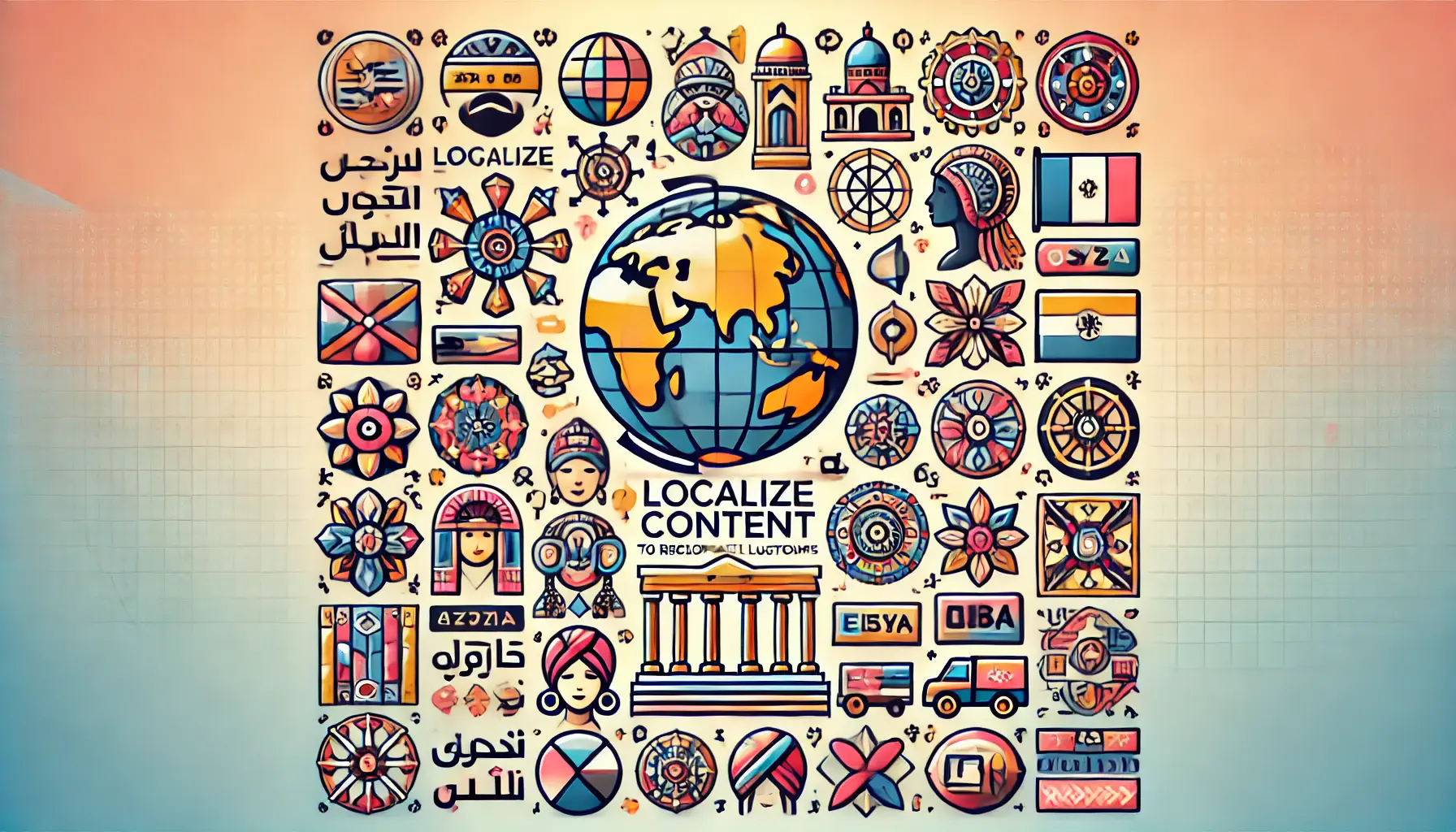
Illustrating the localization of content to reflect regional languages and cultural customs.
Localize Content to Reflect Regional Languages and Customs
Localization is more than translation; it’s about adapting your content to the local language, customs, and cultural nuances.
This process makes your marketing messages more relatable and impactful.
- Language Adaptation: Translate content accurately, considering regional dialects and colloquialisms to ensure authenticity.
- Cultural References: Add local traditions, holidays, and societal norms to make your content culturally relevant.
- Visual Elements: Use images, colors, and symbols that hold significance in the local culture to enhance relatability.

Illustrating the concept of building authentic connections through local influencers and social media engagement.
Incorporate Local Influencers to Build Authentic Connections
Collaborating with local influencers can significantly boost your brand’s credibility and reach within a specific market.
Influencers have established trust with their audiences, making your marketing messages more persuasive.
- Identify Relevant Influencers: Choose influencers whose followers align with your target demographic and brand values.
- Authentic Partnerships: Develop genuine relationships with influencers to ensure endorsements are perceived as trustworthy.
- Localized Content Creation: Work with influencers to create content that reflects local culture and resonates with the audience.

Illustrating the alignment of marketing campaigns with local events and cultural traditions.
Align Marketing Campaigns with Local Events and Traditions
Timing your marketing efforts to coincide with local events and traditions can build relevance and participation.
This shows cultural sensitivity and proves that your brand values local customs.
- Event Participation: Sponsor or participate in local festivals, holidays, or community events to increase brand visibility.
- Seasonal Promotions: Provide promotions or products relevant to local holidays or seasonal events.
- Custom Messaging: Develop marketing messages that acknowledge and celebrate local traditions, fostering a closer bond with the audience.
By customizing your marketing messages to local cultures, you create a more personalized experience for consumers.
Such cultural sensitivity not only enhances engagement but also builds long-term loyalty, strengthening your global marketing efforts.
Localizing your marketing message strengthens cultural relevance and builds trust. Consider adapting visual elements, language, and traditions for maximum impact.

Visualizing data analytics to monitor and improve marketing campaign performance.
Utilize Data Analytics to Monitor and Improve Campaigns
In today’s data-driven marketing landscape, leveraging data analytics is crucial for monitoring and enhancing the effectiveness of your global marketing campaigns.
By harnessing advanced analytics tools, you can gain valuable insights into customer behavior, campaign performance, and market trends, enabling you to make informed decisions and optimize your strategies.

Visualizing customer trends with an interactive analytical dashboard.
Track Customer Trends with Analytical Dashboards
Analytical dashboards provide a real-time view of key performance indicators (KPIs), helping you monitor customer trends.
These dashboards aggregate data from various sources, offering a comprehensive picture of how customers interact with your business and what they like.
- Real-Time Monitoring: Have immediate access to data to instantly recognize changes in customer behavior or market dynamics.
- Customizable Visualizations: Customize dashboards to only show metrics that answer questions about your specific business goals and marketing objectives.
- Interactive Analytics: Drill into segments of data for deeper insights to determine where improvements are needed.

Visualizing the comparison of campaign performance across global markets using data and charts.
Measure Campaign Performance Across Different Markets
Assessing the performance of campaigns across different regions is crucial for understanding how well they are meeting their objectives and where optimization is needed.
Data analytics helps you understand how different audiences respond to your marketing initiatives.
- Regional Performance Metrics: Analyze metrics such as conversion rates, engagement levels, and return on investment (ROI) specific to each market.
- Segmentation Analysis: Segment data by demographics, behaviors, or other relevant factors to gain insights into different audience groups.
- Comparative Analysis: Compare performance across regions to identify best practices and areas needing attention.

Visualizing data-driven decision making with real-time analytics for continuous improvement.
Make Data-Driven Decisions for Continuous Improvement
A data-driven approach enables you to make decisions based on empirical data rather than assumptions.
This is essential for continuous improvement in your marketing strategies.
- Predictive Analytics: Leverage past data to predict the likelihood of future trends and behaviors among your customers, allowing for timely strategy adjustments.
- Optimization Algorithms: Use algorithms to test and refine various aspects of your campaigns, such as messaging, targeting, and timing.
- Performance Benchmarking: Set benchmarks based on data insights to measure success and identify areas for enhancement.
By effectively utilizing data analytics, you can monitor and improve your global marketing campaigns, ensuring they are responsive to customer needs and market conditions, ultimately leading to greater success and growth.
Data analytics helps refine global marketing campaigns. Use insights to measure performance and make data-driven decisions for continuous improvement.

Illustrating the seamless connection between digital and physical marketing strategies.
Integrate Online and Offline Marketing Strategies
In today’s digitally connected world, integrating online and offline marketing strategies is crucial for businesses aiming to offer a seamless and effective omnichannelA seamless approach to customer experience that integrates multiple marketing and sales channels. experience for their customers.
An omnichannel approach enhances customer engagement and loyalty while maximizing the reach and effectiveness of marketing campaigns.
By mixing digital and physical interactions, you’ll be able to meet customers where they are and provide a consistent brand experience across touchpoints.

Illustrating consistent branding across digital and physical marketing channels.
Develop a Unified Brand Message Across Channels
Consistency is key when integrating online and offline marketing efforts.
Your brand message should be uniform across all platforms to build recognition and trust.
This unified approach ensures that whether a customer encounters your brand online or in a physical store, they receive the same message and experience.
- Consistent Visual Identity: Utilize the same logos, color schemes, and design elements in all marketing materials to create brand recognition.
- Unified Messaging: Ensure the tone, language, and key messages are consistent across all channels, avoiding confusion and building strong brand identity.
- Integrated Campaigns: Design marketing campaigns that span online and offline channels, creating a cohesive narrative that will engage customers at multiple touchpoints.
Leverage Data to Enhance Customer Experience
Utilizing data analytics is essential for understanding customer behavior and preferences, enabling you to tailor your marketing strategies effectively.
By analyzing data from both online and offline sources, you can gain comprehensive insights into customer interactions and optimize your campaigns accordingly.
- Customer Segmentation: Analyze customer data to identify distinct segments based on demographics, purchasing behavior, and preferences, allowing for targeted marketing efforts.
- Behavioral Insights: Track customer interactions across various channels to understand their journey and identify opportunities for engagement.
- Performance Metrics: Monitor key performance indicators (KPIs) across all channels to assess the effectiveness of your marketing strategies and make data-driven decisions.

Illustrating the integration of cross-channel promotions across digital and physical marketing platforms.
Implement Cross-Channel Promotions
Encouraging customers to engage with your brand across multiple channels can increase brand loyalty and sales.
Cross-channel promotions create opportunities for customers to interact with your brand in various ways, enhancing their overall experience.
- Exclusive Offers: Provide special deals or discounts that are available only through specific channels, incentivizing customers to explore different touchpoints.
- Event Integration: Host events that connect online and offline experiences, such as live in-store events streamed online or online sneak peeks of in-store promotions.
- Loyalty Programs: Incentivize customers through loyalty programs that encourage them to interact with your brand on multiple touchpoints, fostering deeper brand intimacy and repeat business.
Integrating online and offline marketing will lead to a harmonious and interactive experience for customers, which in turn creates brand loyalty and business growth.
It also allows you to not only increase customer satisfaction but also gain valuable insights into customer behavior, driving constant improvement in your marketing efforts.
Seamless integration of online and offline strategies enhances customer engagement. Unified messaging across channels ensures consistency and maximizes reach.

Visualizing the strategy of integrating global marketing with local store advertisements.
Summary: Strategizing Global Marketing with Local Store Ads
In conclusion, mastering global marketing while integrating local store ads requires a thoughtful and strategic approach that combines the best of both worlds.
By understanding your target audience across different regions, leveraging data analytics, and adapting your marketing message to suit local cultures, you can create an omnichannel experience that resonates with diverse audiences while driving conversions.

undefined
Key Takeaways from Effective Global Marketing Strategies
Throughout the article, we’ve discussed several crucial strategies for effectively blending global marketing with local store ads.
Here are the main points to remember:
- Understand Your Audience: Segment your audience based on cultural, economic, and behavioral differences to tailor your marketing efforts more effectively.
- Leverage Location-Based Advertising: Employ geo-targeting and location-based services to reach the right customers at the right time.
- Adapt to Local Cultures: Customize your marketing content to reflect regional languages, traditions, and preferences for a more personalized experience.
- Utilize Data Analytics: Monitor customer trends, measure campaign performance, and make data-driven decisions to continually improve your marketing strategies.
- Integrate Online and Offline Channels: Create seamless experiences across both online and offline platforms to maximize engagement and brand visibility.

Visualizing the future of global marketing with technological advancements like AI, data analytics, and virtual reality.
The Future of Global Marketing
As businesses continue to expand globally, the need for effective integration of online and offline strategies will only grow.
By adopting the techniques discussed in this article, you can stay ahead of the curve and maintain a competitive edge in the ever-evolving landscape of global marketing.
Ultimately, global marketing is about understanding your customers, adapting to their needs, and delivering consistent and relevant content across multiple platforms.
The right combination of strategic planning, technology, and local knowledge can make all the difference in achieving your marketing goals.
Combining global reach with local strategies creates a competitive edge. Focus on audience understanding, cultural adaptation, and integrated marketing for success.
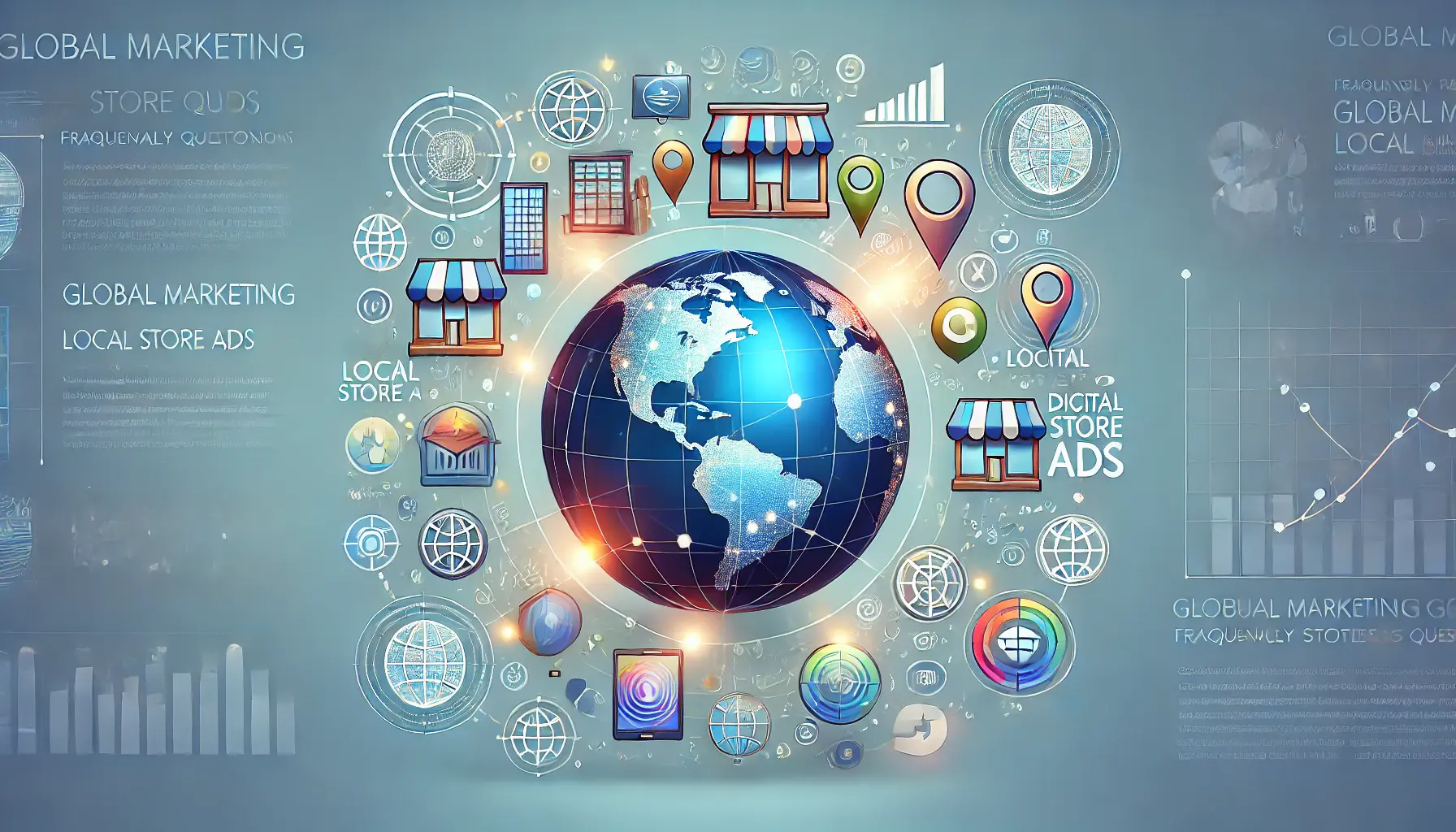
Illustrating the integration of global marketing strategies with local store advertisements.
Your campaigns can be managed by an agency specialized in Google Ads, check out our service page.
Global Marketing for Local Store Ads: Frequently Asked Questions
Global marketing for local store ads includes developing marketing campaigns that promote a company’s products or services to a global audience, while tailoring the messaging to fit the specific cultures and tastes of local populations.
Understanding your target audience is essential because it allows you to tailor your marketing efforts to meet the specific needs, preferences, and behaviors of different cultural and regional groups, leading to more effective campaigns.
Data analytics can enhance global marketing strategies by providing insights into customer behavior, campaign performance, and market trends, enabling businesses to make informed decisions and optimize their marketing efforts.
Localization plays a significant role in global marketing by adapting marketing content to reflect regional languages, traditions, and preferences, ensuring that the messaging resonates with local audiences and builds trust.
Businesses can integrate online and offline marketing channels by creating cohesive campaigns that provide a seamless experience across both platforms, ensuring consistent messaging and maximizing engagement with the target audience.
Effective location-based advertising techniques include geo-targeting, utilizing location-based services, and optimizing local listings to enhance discoverability and provide personalized promotions to customers based on their geographical location.
Adapting marketing messages to local cultures is important because it ensures that the content is relevant, respectful, and resonates with the local audience, leading to increased engagement and brand loyalty.
Businesses can measure the success of their global marketing campaigns by tracking key performance indicators (KPIs) such as conversion rates, engagement levels, and return on investment (ROI) specific to each market.
Challenges businesses might face include cultural differences, language barriers, varying consumer behaviors, and the need to adapt marketing strategies to diverse regional preferences and regulations.










